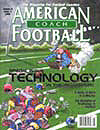AMERICAN FOOTBALL MONTHLY THE #1 RESOURCE FOR FOOTBALL COACHES
Article CategoriesAFM Magazine
|
The Evolution of Technology in FootballReflections on How We Arrived Here and What the Journey Tells Us About the Futureby: Samuel G. Covault, Ph.D., Athle-Tech © More from this issue CLICK...CLACK...CLICK...CLACK.... the only sound emanating from the darkened room droned endlessly. For decades, it was the sound of technology in football. For generations of players and coaches, the first technological skill to be mastered was how to thread film in the 16mm projector. It was film, passing back and forth through the projector's gate, which was the sound of technology in the game. An endless ribbon of film ran through the game and connected generations of coaches and players. As I honor AFM's request to reflect on the evolution of technology in football, I'm reminded of a special memory, of a time when I began to learn the skills of the profession. It was the summer of 1975, I had just joined the staff of the late Bill Hess at Ohio University. As were two other fine head coaches for whom I've worked, Bill Ma....The full article can only be seen by subscribers.
|
|
|||||||
| HOME |
MAGAZINE |
SUBSCRIBE | ONLINE COLUMNISTS | COACHING VIDEOS |
Copyright 2025, AmericanFootballMonthly.com
All Rights Reserved





